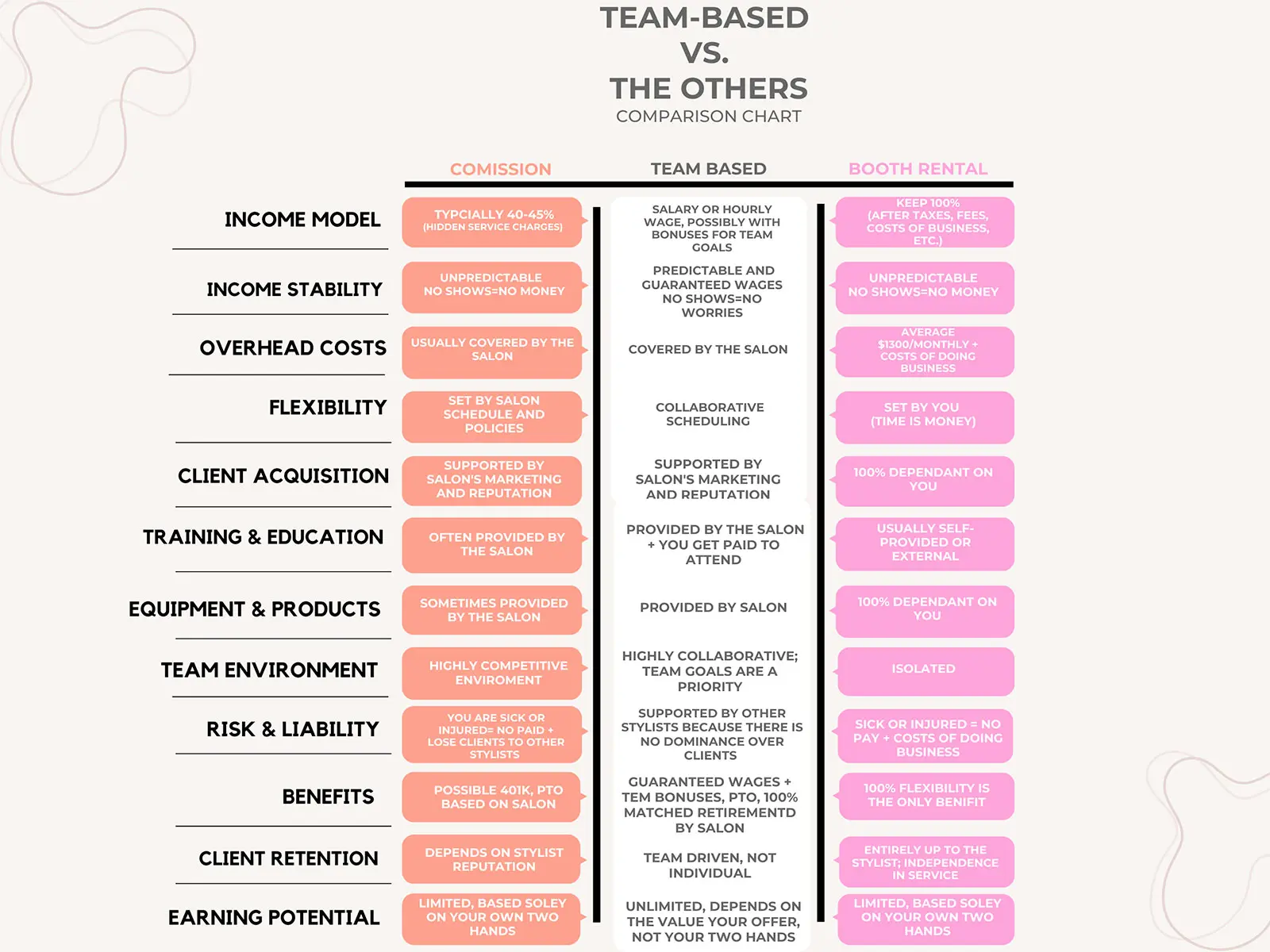
Whether you’re a budding stylist or a seasoned pro, the hair industry offers diverse career paths. Here, we delve into some of the most prevalent models, starting with the time-honored commission-based system. In this model, stylists earn a fraction of the salon’s earnings for every service they render, typically 30-45%. This percentage fluctuates based on salon policies, stylist experience, and performance metrics. For instance, while a salon might say they pay 50% commission, a new stylist might not be aware that hidden “service” charges (typically 10-12%) are also being deducted for each service, making it impossible for the stylist to calculate.
 Next on the list is the allure of booth or suite rentals. This pathway often captivates those yearning for entrepreneurial autonomy, promising potential peaks in income. In reality, earning potential is extremely limited, and when compared to traditional salon ownership, your operating costs are obscenely high. Your responsibilities don’t differ from those of a typical salon owner—however, you will be solely responsible for carrying them yourself. This model comes with many more challenges:
Next on the list is the allure of booth or suite rentals. This pathway often captivates those yearning for entrepreneurial autonomy, promising potential peaks in income. In reality, earning potential is extremely limited, and when compared to traditional salon ownership, your operating costs are obscenely high. Your responsibilities don’t differ from those of a typical salon owner—however, you will be solely responsible for carrying them yourself. This model comes with many more challenges:
- Financial Undertakings: Remember, salon suites function as standalone businesses. Signing a lease implicates financial risk and overhead costs like furnishing, equipment, insurance, and more. Conversely, joining a well-established salon equips you with everything needed to kickstart your career.
- Client Management: While some salon suites offer online booking tools, these rarely match the caliber of services provided by a salon’s dedicated hospitality team. Managing appointments and incredibly fickle clients can be overwhelmingly hands-on. Playing schedule Tetris on your time off for hours isn’t fun.
- Social Media Quagmire: Today’s digital age mandates an active social media presence. Unlike salons that often have teams to manage content creation, suite renters find themselves investing extra hours into their digital presence.
- Client Acquisition: Beyond social media, suite renters must devote time to optimizing their Google My Business, crafting a professional website, and managing client communications. It is a highly daunting and challenging task building a clientele without the help of a bustling salon.
- Atmospheric Disparities: There’s an undeniable charm to the vibrancy of high-end salons – the interactions, music, and complimentary treats amplify the experience. A salon suite, in contrast, offers a subdued ambiance and a lonely vibe.
- Collaborative Learning: Traditional salons buzz with conversations about the latest beauty trends and innovative techniques. Solo suite renters often miss out on this collective learning experience.
- Educational Prospects: Continuous learning is pivotal for a stylist. While salons frequently curate structured educational programs, suite renters must independently navigate their learning journeys.
- Inventory Management: Managing inventory is an added task for suite renters, who often miss out on bulk purchase discounts that larger salons enjoy. In fact, it’s not unusual for company consultants to “blow you off” because you are “too small” and not worth their time.
- Handling Difficult Clients: Every client is unique. Established salons often have teams trained to manage challenging situations, shielding stylists from potential conflicts. Suite renters, however, must face these situations head-on alone.
- Team Spirit: The essence of camaraderie is palpable in bustling salons. Working solo might grant independence but also means missing out on the shared joys, commiserations, and collective achievements that team environments foster.
The Essence of a Team-Based Salon
 At its core, a team-based salon focuses on collective success rather than individual achievements. Here, everyone from the receptionist to the senior stylist plays a vital role in ensuring the salon’s growth and the satisfaction of each client. The philosophy is simple: when the salon succeeds, every team member reaps the rewards. This collaborative approach fosters a culture where:
At its core, a team-based salon focuses on collective success rather than individual achievements. Here, everyone from the receptionist to the senior stylist plays a vital role in ensuring the salon’s growth and the satisfaction of each client. The philosophy is simple: when the salon succeeds, every team member reaps the rewards. This collaborative approach fosters a culture where:
- Learning is Continuous: There’s a shared commitment to professional growth. Regular training sessions, workshops, and exposure to the latest trends ensure that every stylist is at the top of their game.
- Support is Unwavering: Whether it’s a challenging client or a tricky hair technique, team members lean on each other for guidance, ensuring that challenges are met with collective wisdom.
Why Team-Based Salons Triumph Over Commission & Suite Rental Models
- Consistent Income: Unlike the other models where earnings are unpredictable, team-based salons provide stable salaries. This ensures that stylists can focus on honing their skills without financial stress. In fact, most stylists earn more in a team-based salon than the other two models. See chart above.
- Shared Responsibilities: In suite rentals, stylists are bogged down by the weight of running every aspect of a business, from marketing to inventory management. In contrast, team-based salons distribute these responsibilities, ensuring that stylists can prioritize their primary passion – creating stunning hair transformations.
- Community Over Competition: The traditional commission model will inadvertently promote competition among stylists, as everyone vies for the highest earnings. In team-based settings, the focus shifts to collaborative growth. Successes are celebrated together, and challenges are addressed as a unit.
- Diverse Learning Opportunities: Being surrounded by a team of varied talents means constant learning. Whether it’s a new coloring technique or a fresh take on a classic cut, there’s always someone to learn from.
- Enhanced Client Experience: With a cohesive team, clients benefit from a seamless salon experience. From the warm greeting at the reception to the final styling touches, every step is orchestrated in harmony, ensuring clients leave with a smile.
- Flexibility: Team-based salons often provide more scheduling flexibility. If a stylist needs time off, there’s a team ready to ensure that clients are well taken care of. In fact, there is always a support system behind you if you are sick, injured, or away on vacation.
- Holistic Growth: In a team setting, growth isn’t just about acquiring new hair skills. It’s about personal development, learning team dynamics, and understanding the nuances of running a successful salon business.

